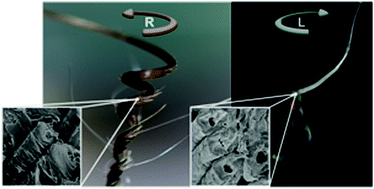Reversible water driven chirality inversion in cellulose-based helices isolated from Erodium awns†
Abstract
Among the movements observed in some cellulosic structures produced by plants are those that involve the dispersion and burial of seeds, as for example in Erodium from the Geraniaceae plant family. Here we report on a simple and efficient strategy to isolate and tune cellulose-based hygroscopic responsive materials from Erodium awns’ dead tissues. The stimuli-responsive material isolated forms left-handed (L) or right-handed (R) helical birefringent transparent ribbons in the wet state that reversibly change to R helices when the material dries. The humidity-driven motion of dead tissues is most likely due to a composite material made of cellulose networks of fibrils imprinted by the plant at the nanoscale, which reinforces a soft wall polysaccharide matrix. The inversion of the handedness is explained using computational simulations considering filaments that contract and expand asymmetrically. The awns of Erodium are known to present hygroscopic movements, forming R helices in the dry state, but the possibility of actuating chirality via humidity suggests that these cellulose-based skeletons, which do not require complicated lithography and intricate deposition techniques, provide a diverse range of applications from intelligent textiles to micro-machines.



 Please wait while we load your content...
Please wait while we load your content...